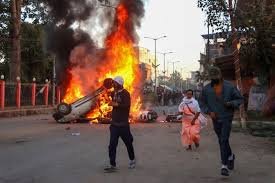As Bihar heads to polls, Congress hard bargaining for 60+ seats despite limited strength, reviving fears it could again sink the INDIA bloc’s prospects.
BY Navin Upadhyay
In the keenly fought Bihar Assembly elections of 2020, the Congress party entered the fray with grand ambitions, contesting 70 seats as part of the Mahagathbandhan (Grand Alliance). The outcome, however, was disastrous: only 19 victories and a dismal strike rate of 27%. This performance proved to be the Achilles’ heel of the alliance led by Lalu Prasad Yadav’s Rashtriya Janata Dal (RJD). The bloc — then known as the Grand Alliance — won 110 seats in the 243-member Assembly, falling just 12 short of the majority mark.
The postmortem was swift and brutal. Congress’s uninspired campaign, poor ground coordination with the RJD, and Rahul Gandhi’s sporadic appearances turned what could have been a narrow win into a painful defeat. Disillusionment ran deep within the opposition ranks — the alliance had the numbers on paper, but not the chemistry on the ground.
Déjà vu in 2025
Fast-forward to October 2025, and the echoes of that 2020 debacle are unmistakable. As Bihar readies for its two-phase polls on November 6 and 11 — with counting on November 14 — the Congress once again appears to be the INDIA bloc’s weak link.
While the NDA has swiftly settled its formula — BJP and JD(U) contesting 101 seats each, with smaller partners like LJP(RV) getting 29 — the Mahagathbandhan remains mired in delays. Despite multiple high-level huddles in Delhi, the alliance, which includes the RJD, Congress, Left parties, and the Vikassheel Insaan Party (VIP), has yet to release a unified seat-sharing blueprint.
This is no mere procedural snag. It mirrors the arrogance of 2020, potentially handing the BJP–JD(U) combine an early advantage in a state ripe with anti-incumbency against Nitish Kumar’s flip-flops.
At the center of the logjam is Congress’s demand for 60 + seats, a number that many allies deem wildly unrealistic given its skeletal organisation and depleted cadre. In 2020, the party’s overreach cost the alliance dearly — the RJD’s 75 seats could not offset Congress’s drag factor. Now, the scenario looks dangerously similar.
Reports suggest that RJD chief Lalu Prasad Yadav has offered Congress 52–58 seats, with only a handful still in contention — including politically sensitive battlegrounds like Bachhwara, Aurai, Harlakhi, Matihani, and Parbatta. CPI(ML) Liberation leader Dipankar Bhattacharya, whose party hopes to contest 40 seats (up from 19 in 2020), has publicly urged Congress to “be realistic” and focus on winnable constituencies.
Unmoved, Congress’s Central Election Committee has already cleared 25 candidates and even instructed its Bihar unit to prepare a full 243-seat slate — a move seen by allies as brinkmanship and a possible prelude to going solo if talks collapse.
READ: IRCTC Scam: The “Extra Player” in Bihar’s Political Game
On social media, criticism has been merciless. One user on X lambasted Congress’s “pathetic demands for 65–70 seats without any organisational presence,” reflecting a growing perception that the party remains more liability than asset.
The Faltering Campaign
Rahul Gandhi’s much-publicised ‘Vote Adhikar Yatra’, a 1,300-km march from Gaya to Patna in August, briefly ignited enthusiasm by spotlighting alleged deletions of 65 lakh names from Bihar’s electoral rolls during the Election Commission’s Special Intensive Revision. But what began as a bold campaign against voter suppression fizzled into a credibility crisis — and did little to strengthen Congress’s grassroots network. It’s shocking how Rahul Gandhi abandoned the “vote theft’ campaign after putting so much time and energy into it. And that too when the final voter list has glaring loopholes with nearly 15 lakh duplicate voters as flagged by the Reporters’ Collective.
Rahul’s Absence and Political Optics
As crucial seat-sharing talks reached their peak in late September, Gandhi embarked on a 15-day tour of Latin America — covering Brazil, Colombia, Peru, and Chile — to meet students, entrepreneurs, and politicians. BJP IT cell chief Amit Malviya mocked the trip, saying Gandhi was “learning to brew coffee in Colombia while Bihar burned.”
Congress tried to counter the optics with videos of Gandhi discussing “India’s destroyed scientific temper” abroad, but the damage was done.
READ: Charges Framed Against Lalu & Family, But Can NDA Make It an Issue?
Rahul’s apathy grew sharper on October 13, when Lalu Prasad and Tejashwi Yadav visited Delhi for the IRCTC scam hearing. Tejashwi met Congress leaders KC Venugopal and Shakeel Ahmad Khan, but Rahul Gandhi stayed away — no meeting, no photo-op, no show of solidarity. The silence spoke volumes.
The Stakes and the Symptoms
Meanwhile, the RJD and Left are visibly more grounded. Tejashwi’s promise of 10 lakh jobs resonates with Bihar’s youth, while Prashant Kishor’s Jan Suraaj Party lurks as a wildcard, contesting all 243 seats on an anti-corruption platform. The AIMIM, denied entry into the INDIA bloc, plans to contest 100 seats in Seemanchal — threatening to split Muslim votes.
In this combustible mix, Congress’s shortage of strong candidates and its erratic leadership could again prove decisive. Bihar, home to 7.9 crore voters and a history of political earthquakes, offers the INDIA bloc a rare chance to challenge the NDA’s Nitish–Modi axis. But if Congress repeats its old mistakes — overreaching, underperforming, and undervaluing its allies — it could once again script defeat from the jaws of opportunity.
The board is set. The pawns are restless. November will tell.













